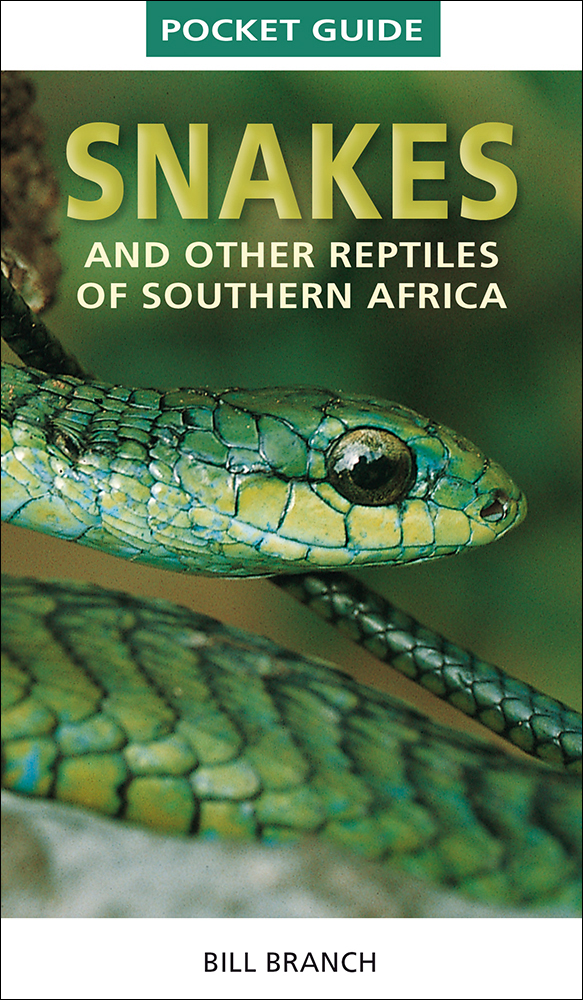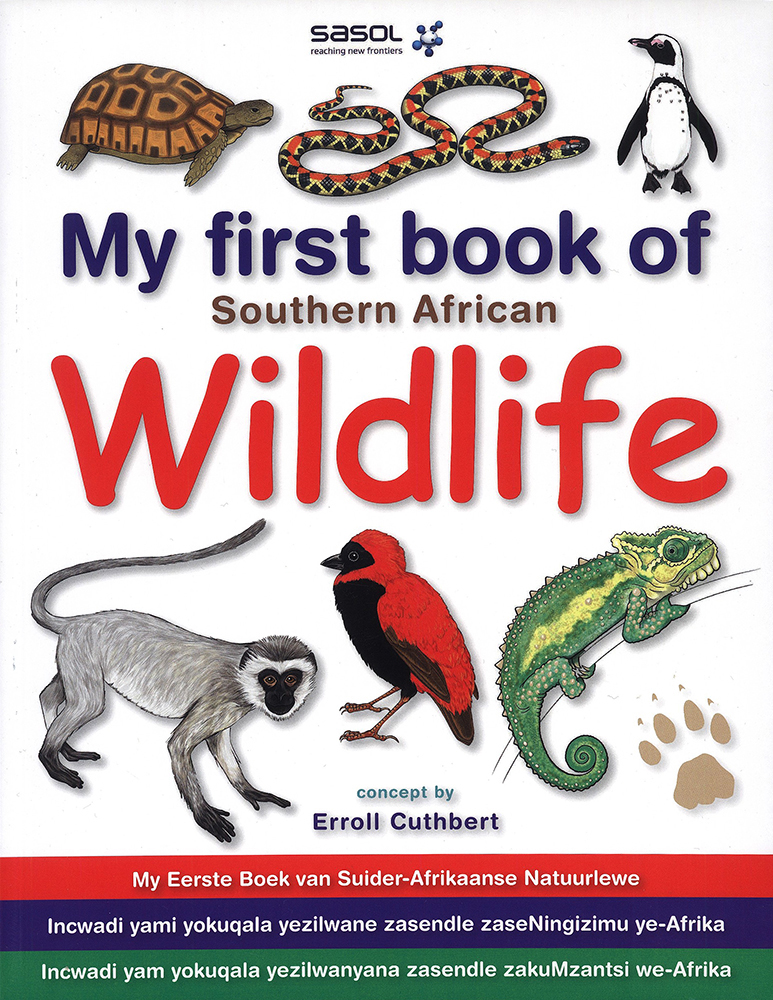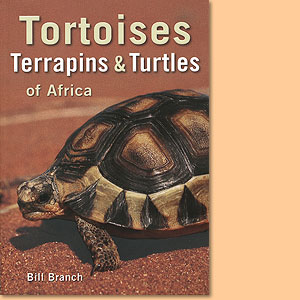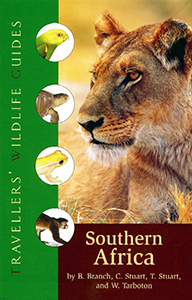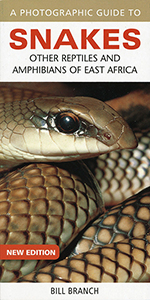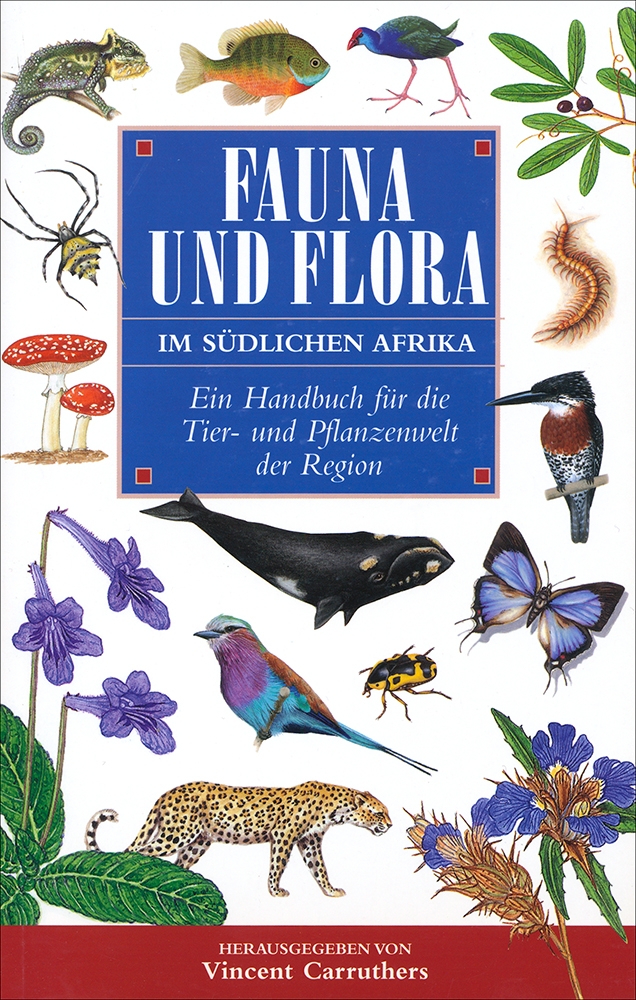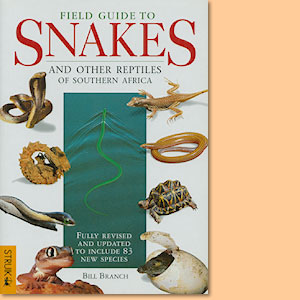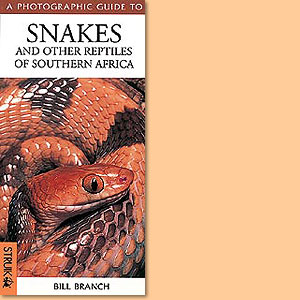Snakes and other Reptiles of Southern Africa (Pocket Guide), by Bill Branch
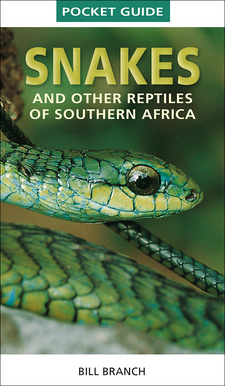
Snakes and other Reptiles of Southern Africa (Pocket Guide), by Bill Branch. Penguin Random House South Africa (Struik Nature). Cape Town, South Africa 2016. ISBN 9781775841647 / ISBN 978-1-77584-164-7
Bill Branch's Pocket Guide to Snakes and other Reptiles of Southern Africa features 276 species you are most likely to encounter.
With increasing public concern for the environment, and the emergence of the 'citizen scientist', interest in less-fashionable wildlife such as reptiles and amphibians has increased. If we are to return to a state of harmony with our world, and to integrate with the biosphere rather than continually exploit it, then we need a deeper understanding of life around us. This book is designed to introduce the region's reptiles, from the feared snakes and crocodile to the ever-popular tortoises and the secretive and neglected lizards. Southern Africa, that region south of the Zambezi and Kunene rivers, has a tremendous variety of habitats. These harbour a diverse reptile fauna of more than 600 species. Nearly 70% of these are endemic to the region, being found nowhere else. Obviously, not all of these can be included in this small book. The species chosen are those that are more colourful and conspicuous, as well as those unique to or endangered in southern Africa. However, a number of rare and localized species have also been included to reflect the great diversity of reptiles the region supports. People generally realize that most snakes are not poisonous, but many still kill them, using the lazy argument that it is 'better to be safe than sorry'. However, of 168 snake species found in southern Africa, less than one-third have venoms of medical significance. Of these, 18 have probably caused death and a further 31 can deliver bites with symptoms ranging from mild to serious. Many regions have fewer than a handful of dangerous species, and it requires little effort to recognize these. All dangerous species are included in this guide.
How to use the Pocket Guide to Snakes and other Reptiles of Southern Africa:
The first requirement for field work is to wear suitable clothing: subdued in colour and robust enough to survive thorns and sharp rocks. Carry a good pair of compact binoculars, which can focus down to 2-3m, as well as a small pocket-sized notebook to record observations. In most of southern Africa, provincial legislation prohibits the collecting, transport or possession of reptiles and amphibians. It is therefore illegal to catch them unless special permission has been obtained. It is also necessary to gain permission to walk or collect on private land. Given these restrictions, however, nothing prevents you from observing and enjoying reptiles in the wild. Bird-spotting is a pastime enjoyed by thousands of South Africans, and there is no reason why reptile-spotting cannot be as enjoyable.
Observing reptiles
Unlike birds, which are often common and highly visible, most reptiles are small, secretive and shy. To find or observe them usually requires patience and careful searching. When in the field, walk slowly and quietly, scanning the ground or rock outcrops ahead. Reptiles are ectotherms and gain their body heat externally, usually from basking in the sun. On cool days or in winter they are rarely active. Being small, they warm up quickly and then usually retreat to shade to avoid overheating and to be less visible to predators. On hot days, they are therefore best observed in the early morning and late afternoon. On overcast days they may be active all day. [...]
This is an excerpt from Snakes and other Reptiles of Southern Africa (Pocket Guide), by Bill Branch.
Title: Snakes and other Reptiles of Southern Africa
Series: Pocket Guide
Author: Bill Branch
Publisher: Penguin Random House South Africa (Struik Nature)
Cape Town, South Africa 2016
ISBN 9781775841647 / ISBN 978-1-77584-164-7
Softcover, 11 x 18 cm, 160 pages, 300 colour photographs, 275 maps
Branch, Bill im Namibiana-Buchangebot
Snakes and other Reptiles of Southern Africa (Pocket Guide)
This pocket guide features 276 species of snakes and other reptiles of Southern Africa.
My first book of Southern African wildlife
My first book of Southern African wildlife introduces children to 58 mammals, 58 birds and 56 reptiles.
My first book of Southern African snakes and other reptiles
My first book of Southern African snakes and other reptiles introduces 56 different species in English, Afrikaans, Zulu and Xhosa and is made for young readers.
Tortoises, terrapins and turtles of Africa
Good colour photographs for easy identification of 46 chelonian species of Africa, tortoises, terrapins and turtles.
Traveller's Wildlife Guide Southern Africa
Traveller's Wildlife Guide Southern Africa introduces 500 of Southern Africa’s most common amphibians, reptiles, birds, and mammals.
A photographic guide to snakes, other reptiles and amphibians of East Africa
This is a handy and well made photographic guide to most of the common snakes, reptiles and amphibians of East Africa.
Fauna und Flora im südlichen Afrika
Fauna und Flora im südlichen Afrika: Ein sehr beliebtes Handbuch für die Tier- und Pflanzenwelt der Region.
Field guide to snakes and other reptiles of Southern Afrika
Fully revised and updated, this field guide to snakes and other reptiles of Southern Afrika includes 83 new species.
A photographic guide to snakes and other reptiles of Southern Africa
Althoug a handy and basic guide, this photographic guide to snakes and other reptiles of Southern Africa shows excellent photographs.

